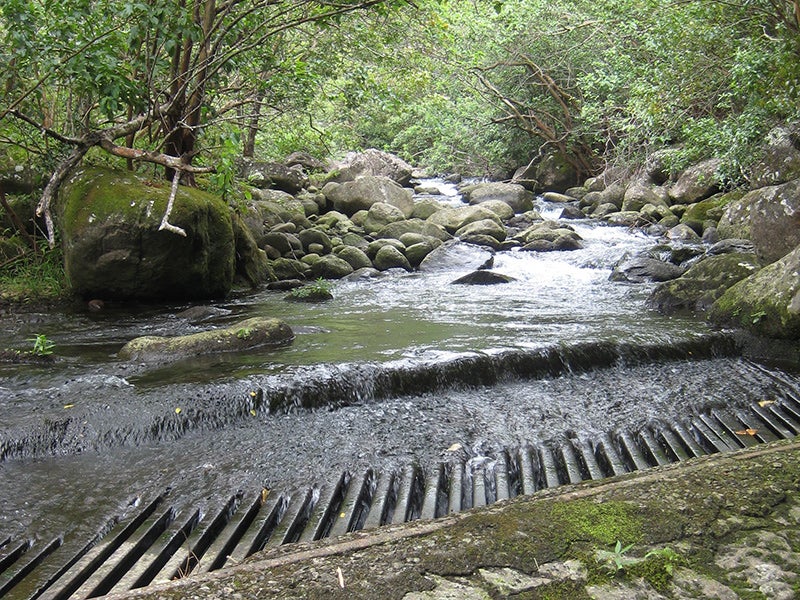Restoring Instream Flow to Maui's "Four Great Waters"
Under modern Hawaiʻi law, the rivers and streams in question (collectively known as Nā Wai ʻEhā—“The Four Great Waters” of Waihe‘e, ʻĪao (traditionally Wailuku), Waiehu, and Waikapū) are a public trust; but since the sugar plantation era, two companies drained them dry for private profit.

This page was published 11 years ago. Find the latest on Earthjustice’s work.
Next week—almost 10 years after Earthjustice started its campaign to restore instream flows to “The Four Great Waters” on Maui—we are again going into legal battle to determine exactly how much more water will be restored.
Under modern Hawaiʻi law, the rivers and streams in question (collectively known as Nā Wai ʻEhā—“The Four Great Waters” of Waihe‘e, ʻĪao (traditionally Wailuku), Waiehu, and Waikapū) are a public trust; but since the sugar plantation era, two companies drained them dry for private profit.
We started our legal action before the state Commission on Water Resource Management in June 2004, obtaining some stream flow restoration to two of the four waters. In August 2012, the Hawaiʻi Supreme Court ruled in our favor that the commission failed adequately to protect public and Native Hawaiian rights to stream flows.
Now, we’re beginning a “second-round” hearing before the commission on March 10.
It has been a long, often frustrating road for us and our client community groups, Hui o Nā Wai ʻEhā and Maui Tomorrow Foundation, and our long-time ally, the Office of Hawaiian Affairs. But as one visionary leader once said, “The arc of the moral universe is long, but it bends toward justice.” After 10 years, the question in this case no longer seems to be “if” substantially more flow will be returning to Nā Wai ʻEhā, but how much.
In the end, I believe this case will stand as a testament to the staying power of grassroots communities committed to justice and the ability of Earthjustice to champion their cause for the duration.
Here’s more background: Nā Wai ʻEhā, which include the two largest rivers on Maui (Waiheʻe and ʻĪao / Wailuku), once sustained legendary watershed ecosystems and the largest expanse of Native Hawaiian wetland kalo (taro) farming in the islands. But from the 19th century, two big plantations wiped this out by taking away the stream flows.
One of the plantations, Wailuku Sugar, closed a quarter-century ago, but no flows returned. Instead, the plantation sold its farmlands to developers and turned into Wailuku Water Company. Together with Alexander & Baldwin, the state’s biggest corporate landowner and developer, which operates the Hawaiian Commercial & Sugar plantation, the water company continued diverting all the stream flows for new business designs based on controlling, developing and selling land and water.
That’s when Earthjustice stepped in on behalf of local and Native Hawaiian communities, demanding that the companies follow the law and let the rivers and streams flow. After a lengthy trial, the hearings officer in April 2009 recommended restoring about half of the 70-million gallons a day the companies diverted. A&B then went political, threatening to shut down HC&S, and the commission wilted.
The commission’s final decision in June 2010 slashed the restoration to only 12.5 million gallons a day for two of the four waters, leaving the other two dry. The commissioner who presided as hearings officer over the entire case dissented, objecting that public waters received mere “leftovers” and “the least protection feasible or no protection at all.”
We appealed to the Hawaiʻi Supreme Court, and it agreed with every major point we raised, throwing out the commission’s decision because it “violated the public trust,” and ordering it to do a better job.
So, round two of our Nā Wai ʻEhā case is underway, and the difference after 10 years (and our court victory) is unmistakable.
Scientists at the U.S. Geological Survey have published several reports confirming that Nā Wai ʻEhā stream flow restoration would not only reestablish native habitats, but also increase recharge of Maui’s main drinking water aquifer. HC&S now admits that it can feasibly use its nonpotable groundwater well as an alternative to stream flow diversions.
And more people than ever understand the ancient and 21st-century value of flowing rivers and streams to perpetuate the cycle of water and life from mauka to makai (mountain to ocean), and its interconnected Native Hawaiian cultural practices and community lifeways.
A core strength of Earthjustice and its Nā Wai ʻEhā partners is that we can, and will, “keep on keeping on” for 10 years, or as long as it takes, to achieve justice. Time will tell how the rest of this case will unfold. But, to quote that visionary leader again, we will not rest until justice—and Nā Wai ʻEhā, The Four Great Waters of Maui—“roll down like waters, and righteousness like a mighty stream.”
For more information, visit restorestreamflow.org.
Update: Aloha, since we first wrote this blog post, the hearing has been postponed until further notice. The state Department of Land and Natural Resources spokesperson announced that this was to allow the parties to discuss “potential avenues for settlement.” We hope to follow up with good news. As always, Earthjustice remains committed that, one way or another, sooner or later, the rivers and streams of Nā Wai ʻEhā will flow.
Established in 1988, Earthjustice's Mid-Pacific Office, located in Honolulu, Hawaiʻi, works on a broad range of environmental and community health issues, including to ensure water is a public trust and to achieve a cleaner energy future.